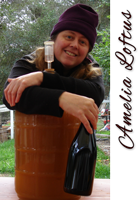Quick Homebrew Slideshow Tutorial
Many people I meet are curious about making beer at home. Sometimes, it is best to illustrate home brewing with pictures. Here is a quick summary of the basic home brewing process. If you are intrigued, you should definitely give it a try!
Weigh the ingredients. Pack fresh grains in a straining bag.
You need healthy yeast to make good beer.
Steep the grains in hot water. When first added, not much happens.
As grains get soaked, starches and enzymes are released into the water and malt sugars are formed. It looks cloudy until all the starches are converted.
After grains are removed, extract is added. Then you must stir...stir...stir to dissolve the extract.
Tasting along the way is a good way to spot potential issues and make adjustments if needed.
Add the hops during the boil.
A vigorous boil helps drive out unwanted compounds, settles proteins to prevent cloudiness, and will utilize the full potential of the hops.
Some flavors, such as these fresh Jalapenos, are best added just before cooling. A copper wort chiller is a strange looking gizmo that cools the boiling hot brew to fermenting temperature quickly.
It is important to clean the fermenting bottle very well.
Strain the finished beer into the fermenter.
Pour in the yeast and give it a good shake.
Ferment in a warm dark place. Use an airlock or a blow-off device to allow fermenting gasses to escape. In 2 to 4 weeks, most brews are ready to drink!
This is just a simplified overview of the brewing process. Hopefully it gives you a good idea of what is involved and will help you with your decision to make the plunge into home brewing. It is easy to learn how to brew good beer, but brewing takes a lot of practice to master. If you want to do well, read a few good books (including my book of course, when it is published) and if possible, find a home brewing friend or group to learn with if you can!

